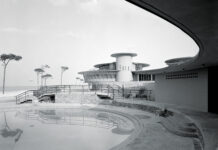
Above An 1817 plan of the works for Pass au Heron from the War Department’s Office of the Chief of Engineers. Image courtesy of the Digital Public Library of America
Nearly lost amid the cluttered detail between Cedar Point and Dauphin Island on the 1856 U.S. Coast Survey Map of Mobile Bay lies Tower Island. At the time, it was an insubstantial patch of oyster shell and sand hard by Grant’s Pass. There was certainly no tower there, nor would there be, despite plans to the contrary. Now safely housed in the National Archives, those plans consist of a single, large construction sheet depicting the elevations and sections of “a tower or resisting post” that looks for all the world like some medieval keep more than a 19th-century fort. If built as drawn, this tower would have constituted one of Mobile Bay’s most unusual landmarks. Its story is a curious local historical episode, involving an ambitious national defense program, an exiled Napoleonic engineer, a fickle Congress and an intervening war.
Immediately after the War of 1812, President James Madison proposed an extensive “third system” of coastal defense — so called after earlier incomplete first and second systems — to avert future catastrophes like the recent burning of Washington, D.C. The plan involved constructing a cordon of brick fortifications at all the nation’s strategic Atlantic and Gulf harbors. Since the French were then the world’s best military engineers, Madison asked the Marquis de Lafayette — so esteemed for his services to the patriot cause during the American Revolution — for a recommendation. Without hesitation the Marquis suggested General Simon Bernard, a distinguished Napoleonic veteran unhappily serving France’s new Bourbon king.
Madison immediately offered Bernard a position as “an assistant in the Corps of Engineers in the United States” with the rank of brevet brigadier general. Bernard accepted and relocated to the United States. Shortly thereafter, President-elect James Monroe, Madison’s successor, explained Bernard’s hiring to Major-General Andrew Jackson. “On the subject of fortifications or works of the defense of the coasts and frontiers, an arrangement has lately been made by the President, with which I wish you to be well acquainted,” he wrote. Monroe declared that Bernard was “inferior to none in reputation and talents” and would lead an appointed board of four American officers. The board planned to personally survey the entire coast to recommend “such works as are necessary for its defense.” Monroe assured Jackson that the Frenchman was “a modest unassuming man” who promised to fully cooperate with local commanders.
By 1817, Bernard had made it to Mobile Bay. Only recently acquired by the Americans, the area occupied a key position between Spanish Florida to the east and the commercially vital Mississippi River to the west. Strong defenses at Mobile Bay not only promised to protect the young American city itself but to deny its use as a base for a land attack on Louisiana or its harbor to an enemy fleet threatening the infant nation’s soft underbelly.
General Bernard carefully consulted local authorities and maps, tramped the surrounding shorelines and scouted key points. He thoroughly inspected the two existing fortifications and found both wanting. Colonial Fort Charlotte sat in downtown Mobile. It had fallen to the Spanish by siege in 1780 and, though repaired, was good for little more than staging troops and supplies. Fort Bowyer stood on Mobile Point at the bay mouth. It was a sun-blasted sand-and-timber redoubt that repelled one British assault in 1814 and fell to another the following year. Clearly, Mobile Bay needed better protection commensurate with its military importance.
In his final report to Congress, Bernard recommended two substantial brick forts flanking the mouth of Mobile Bay — thus the seeds of Forts Morgan and Gaines — and a small Martello tower to guard the bay’s shallow western approach from Mississippi Sound. Martello towers took their unusual name from a corruption of the name Cape Mortella, Corsica, where in 1794, a circular tower fort stymied two British warships. This success prompted the widespread adoption of tower forts by military engineers.
Bernard and his team proposed building the tower on a little island immediately north of Pass aux Heron (Grant’s Pass did not then exist). Their drawings depicted a 108-foot diameter, three-story, hexagonal brick structure with thick walls, gun embrasures, a sally port and a low-slung roof. Twelve guns were to command the Sound from Dauphin Island up to Cedar Point. Ten men would garrison the fort in peacetime and 36 during hostilities. The projected cost was $16,677.
Construction on Forts Morgan and Gaines began in 1819, but Congress cut the latter’s funding in 1821, believing it too far from the ship channel to justify the expense. The Martello tower appears not to have merited further consideration until after Grant’s Pass opened. Combined with the concomitant development of lighter-draft steam warships, defending Mississippi Sound suddenly reemerged as a priority. Revised plans called for a stronger tower with 26 guns, eight of them situated inside casemates on the second level and 12 en barbette, or exposed, at rooftop level. Congress appropriated $100,00 on March 3, 1857, but looming war clouds stalled contracts and the tower remained on the drawing board.
During the Civil War, the Confederates had to protect the sound and hastily erected a sand-and-wood redoubt known as Fort Powell on Tower Island. The federals pummeled it during the Battle of Mobile Bay, prompting its evacuation and destruction. It is doubtful that a Martello tower such as that originally proposed by Bernard would have fared any better, however, since the era’s pulverizing rifled artillery made brick fortifications obsolete. Thus, even if built, the elegant tower might not have survived to the present day. But the drawings are beautiful, and it is intriguing to imagine what might have been. mb
John S. Sledge is the author of Mobile and Havana: Sisters Across the Gulf, available in bookstores locally and online at the universityofalabamapress.ua.edu.





